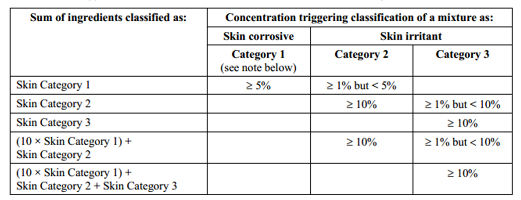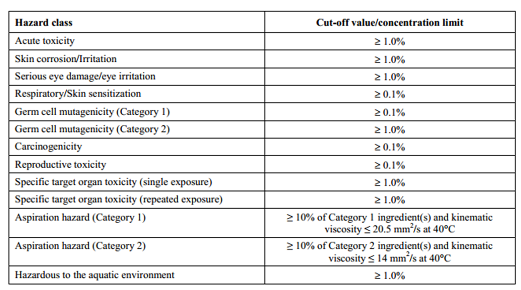GHS Cut-off Value and GHS Concentration Limit
Little Pro on 2016-01-06
GHS cut-off value or GHS concentration limit is the minimum concentration for a hazardous substance to trigger the classification of a mixture containing it. They are mainly expressed as % thresholds and are primarily used for mixture classification under GHS.
The table below is an example of cut-off value/concentration limit for hazard class skin corrosion/irritation. If a mixture contains a hazardous ingredient that has been classified as skin corrosive category 1, the mixture itself will also be classified as skin corrosive category 1 if the concentration of ingredient exceeds 5%.

Cut-off Value vs Concentration Limit
In UN GHS, the cut-off value and concentration limit are equivalent and meant to be used interchangeably. It shall be noted that the EU CLP regulation has given different definitions to cut-off value and concentration limit. In addition to that, Europe has set specific concentration limits for specific substances.
- Cut-off value: minimum concentration for a substance to be taken into account for classification purposes(do not necessarily trigger classification);
- Concentration limit: minimum concentration for a substance to trigger the classification of a mixture for a specific hazard class;
- Specific concentration limit: a concentration limit that is specific to a substance and takes precedence over generic concentration limit or cut-off value.
Special Considerations When Using GHS Cut-off Value and GHS Concentration Limit
There are some special considerations when using cut-off value and concentration limit to classify a mixture:
- Rule 1: Test data always takes precedence over cut-off value/concentration limit;
- Rule 2: If a mixture contains two or more ingredients with the same or similar hazards, the concentration of the hazardous ingredients shall be added first. However, this additivity principle does not apply to non-additive hazard classes and categories.
| Additive hazards |
|
| Non-additive hazards |
|
Generic GHS Cut-off Values for SDSs
GHS has also set generic cut-off values for SDSs. An SDS should be prepared and provided for a substance or mixture meeting classification criteria or for a mixture containing a hazardous ingredient with a concentration exceeding the cut-off limits given in the table below.

Reference & Resources
- Introduction to GHS Classification by the United Nations
- A Summary of GHS Classification Criteria for Substance and Mixture.
- Download Cut-off Value/Concentration Limits for Health Hazards;
- Download Cut-off Value/Limits for Environmental Hazards.
Having Questions?
We do not provide consultancy services. If you have questions or need any help, please contact our sponsor. You may also find an expert in CSP business directory below. If you are a consultant, you may get yourself listed in CSP business directory (free) or sponsor this page to leave your contact info on this page..

Tags: Topics - GHS, GHS Basics and Tutorials